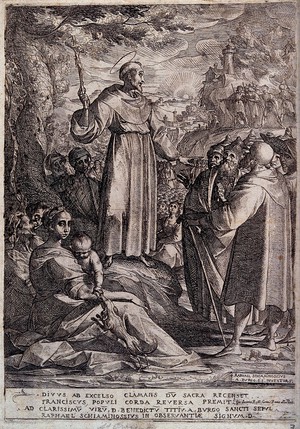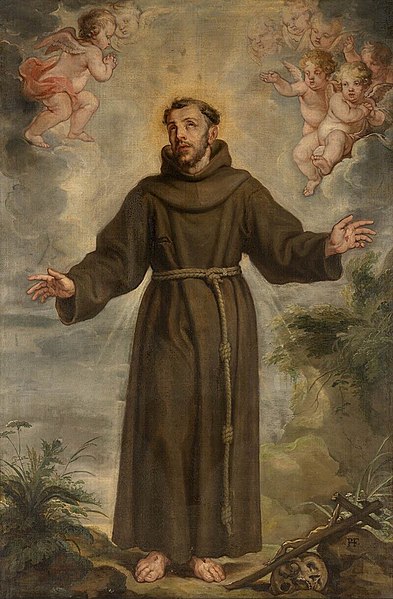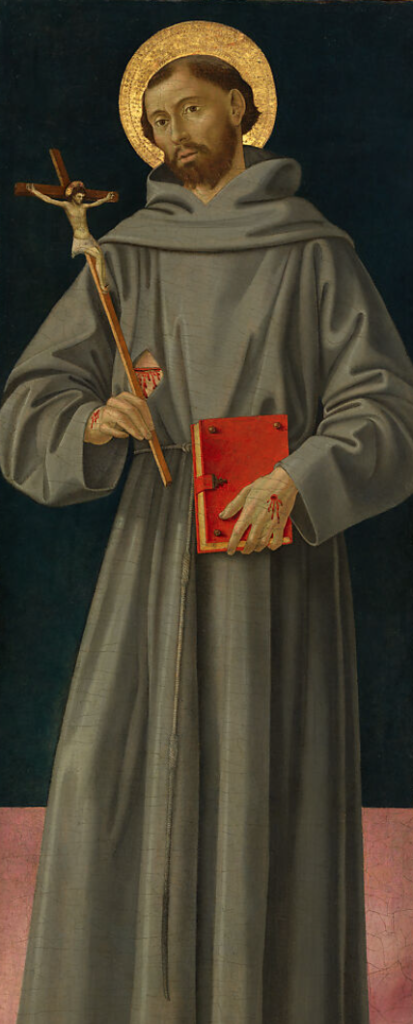A Man of Poverty and Preaching

St. Francis of Assisi is perhaps best known as one of the most beloved saints within the Roman Catholic Church. His life of charity, love of nature, and kind disposition made him a most popular figure in his own time—his monastic order grew to tens of thousands of adherents in his own lifetime—and even down through the ages. Yet his impact is felt today not only by the Roman Church but also by all of Christendom, including Lutherans. More on that below.
Giovanni Bernardone, as Francis was named at birth, was raised in the home of a successful cloth merchant. Because his father’s dealings with the French, Giovanni came to be called Francis (“French”), and the nickname stuck. Francis grew up in the luxury of his father’s wealth, of which he enjoyed the fruits while pursuing worldly honor. One of his attempts at earthly glory began when he set off as a knight in the war against Perugia. His aspirations changed, however, after being taken as a prisoner of war for over a year and facing severe illness while away. These harsh realities drove him back home to Assisi.
After returning home, St. Francis underwent a change of heart. He describes his conversion as a gradual one while at the same time recalling moments of revelation that changed the course of his life and actions forever. For example, Francis said that he received a vision at the altar crucifix to go and repair his Lord’s house, which he went and pursued immediately. Now, while Francis’ father was concerned over his son’s earlier life of lavishness and pleasure, it turns out he was even less happy when Francis exploited his revenue to accomplish this mission to rebuild local churches. With the two men at odds with one another, Francis disowned his father and continued his restoration with more fervor than ever.
Second, St. Francis was attending mass when he heard a lesson from Matthew 10:7-13. Francis took every word to heart and immediately patterned his life after this instruction. He gave everything to the poor and assumed the uniform with which we are all familiar: a simple cloak, a rope around the waist, and nothing else but what the Lord daily provided. Others started joining in, and soon after in 1210 St. Francis and his followers went to Rome and received Pope Innocent III’s permission to become a new religious order, the Order of Friars Minor.
St. Francis’s ambition was to travel widely, but he was mostly prevented by shipwreck and illness. In 1219 he succeeded in visiting Egypt and unsuccessfully tried to convert the Sultan in the midst of the tumultuous crusades. Afterward, he returned to the chapel where his journey had first begun and formally relinquished any authority over the order to pursue a simpler life until his death on October 4th, 1226.
While the Order of Friars Minor is perhaps the most famous institutions connected with Francis, his influence can be felt in yet other orders that he founded. First among these was the Poor Clares, an order for women named after a friend who wanted to follow in Francis’s footsteps. St. Francis also helped establish the Third Order for those who were unable to leave their station to join the Order of Friars Minor but wanted to still follow in Francis’s footsteps within their own stations in life.
Besides these establishments, St. Francis is also known for his love of creation and animals. He is often depicted with these figures, remembered for his compassion towards them.
Brief History

What relevance does St. Francis have for modern Christians, and more specifically, the Lutheran Church? As mentioned above, St. Francis was such a well-loved man from his own time that he was canonized within two years of his death. And while he tends to be particularly beloved in the Roman Church, the Lutheran Church also remembers St. Francis as a faithful saint whose life and example are worth commemorating. As such, he is found in Wilhelm Loehe’s Martyrlogium on October 4th, the traditional date of his commemoration.
For proof that Francis has been esteemed by Lutherans since the Reformation, one need only look to our Lutheran Confessions. There he is held forth as an example of one whose faith in Jesus’ atonement led him into a life of extreme self-denial as a response to his faith in Jesus’ full atonement for him. In this he is unlike those who would come after him and emphasize the self-denial as a means of achieving grace. In this way, St. Francis lived out a life of faith that can be appreciated by Lutherans who are careful to guard against giving the impression that one can do enough good to earn God’s favor. St. Francis is also credited within our confessions for his encouragement against the celebration of private masses and support of a single, daily mass, a point which the Lutheran reformers themselves would take up 300 years later.
Finally, St. Francis’ Peace Prayer remains a popular prayer among Christians alike, written below:
Lord, make us instruments of your peace.
Where there is hatred, let us sow love;
where there is injury, pardon;
where there is discord, union;
where there is doubt, faith;
where there is despair, hope;
where there is darkness, light;
where there is sadness, joy.
Grant that we may not so much seek
to be consoled as to console;
to be understood as to understand;
to be loved as to love.
For it is in giving that we receive;
it is in pardoning that we are pardoned; and
it is in dying that we are born to eternal life. Amen.

Collect
O God, Who, through the example of Blessed Francis, didst increase Thy Church by enriching her with renewed fervor: grant us, that in imitating him, we may despise earthly good and always rejoice in partaking of Thy heavenly gifts; through Jesus Christ, Thy Son, our Lord, who liveth and reigneth with Thee and the Holy Ghost: ever one God, world without end. Amen.
Lessons
Resources
Propers found in Daily Divine Service Book: A Lutheran Daily Missal, edited by the Rev. Heath Curtis
References:
1. Pfatteicher, Philip H. Festivals and Commemorations. Augsburg Publishing House. 1980.
2. Walker, Williston. A History of the Christian Church. Charles Scribner’s Sons. 1985.
Images:
1. Saint Francis of Assisi holding a crucifix, preaching to a crowd of people, R. Schiaminossi, Italy, 1602.
2. Saint Francis of Assisi Philip Fruytiers, Belgium, ca. 17th Century.
3. Saint Francis of Assisi, Antoniazzo Romano, Italy, 1480-81.


